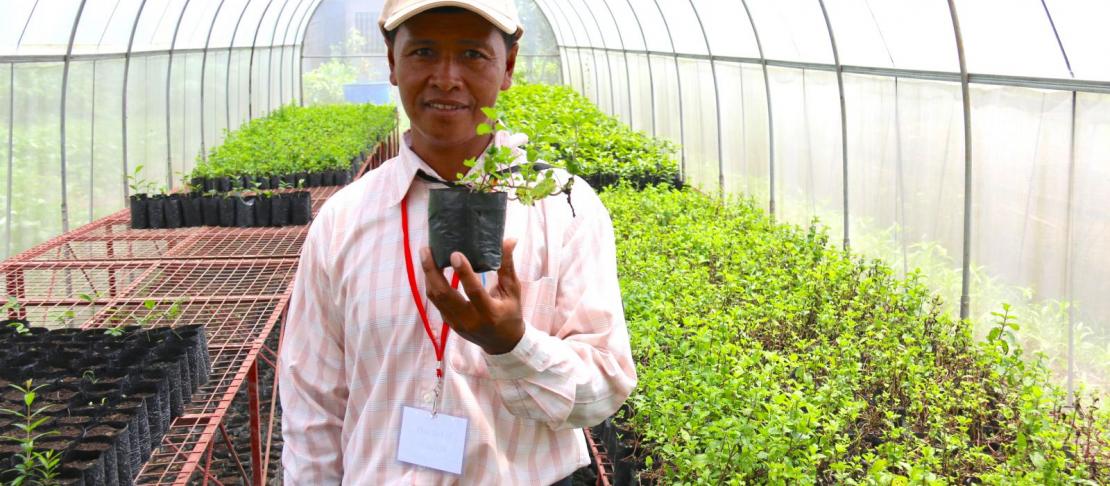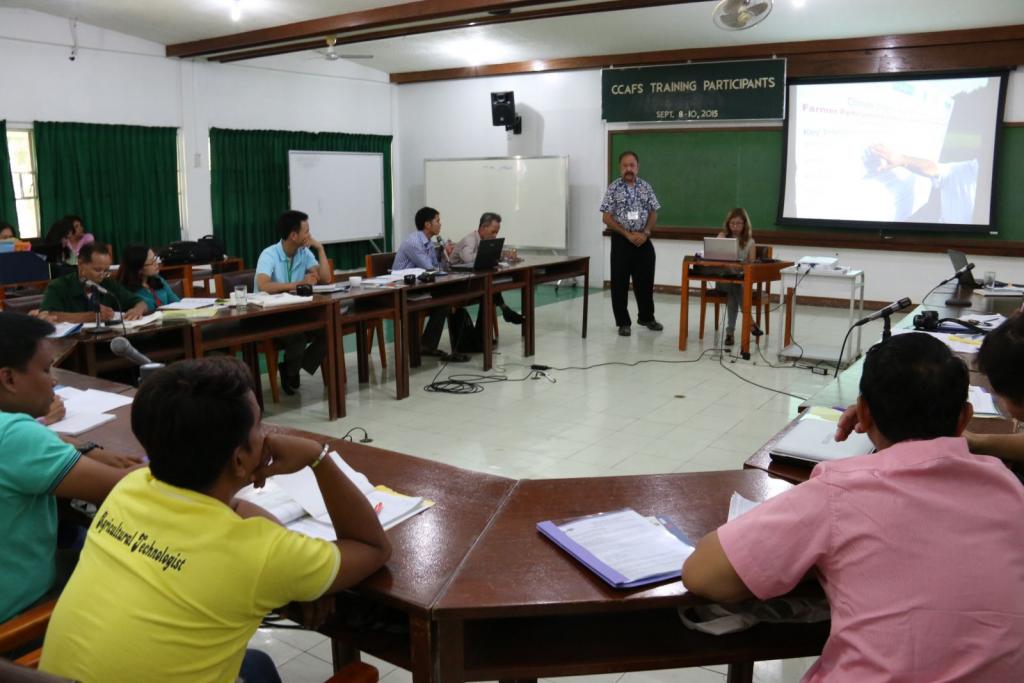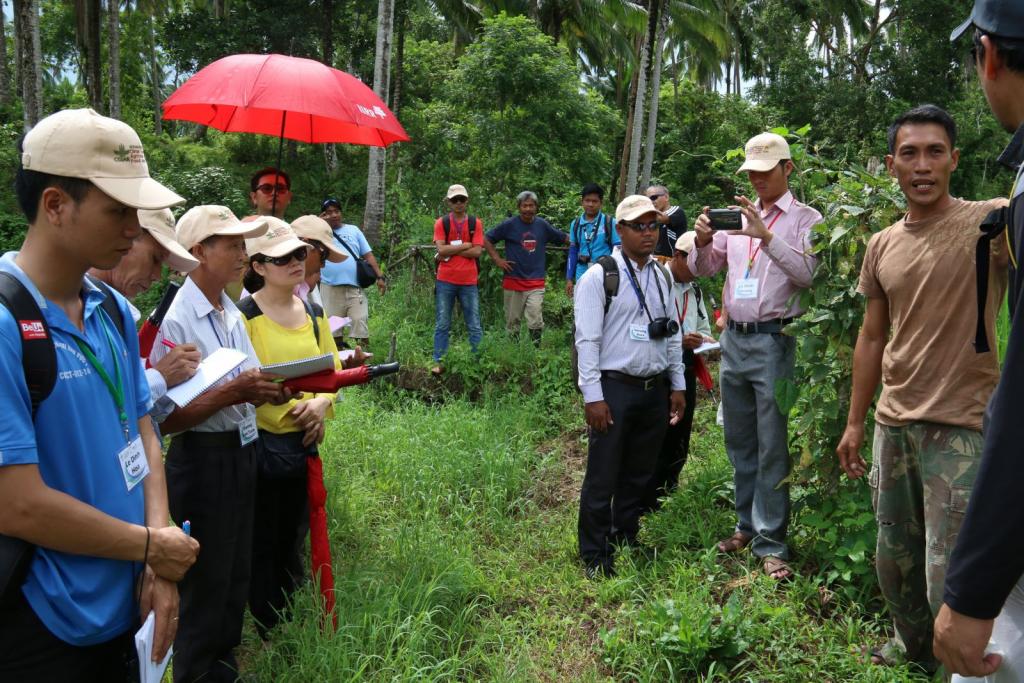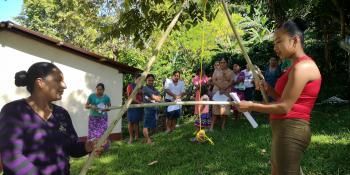Farmers in Southeast Asia learn about climate-smart agriculture practices

Community leaders and organizers from six Climate-Smart Villages in Southeast Asia learned about climate change adaptation and mitigation in the Philippines.
It was the first day of the training but language barriers were immediately broken. Each participant from different countries listened intently to a Filipino farmer who shared his tale of success. The message was translated from Filipino to English to each of their respective languages (Vietnamese, Khmer, Lao). Murmurs heard through the field signalled that information was making its way across people of different languages - and the time it took didn't matter.
Together with the CGIAR’s Research Program on Climate Change, Agriculture, and Food Security in Southeast Asia (CCAFS SEA) and participants from Climate-Smart Villages (CSVs) in Cambodia, Laos, Vietnam and the Philippines, the International Institute of Rural Reconstruction (IIRR) conducted the 'Training Course on Climate-Smart Agriculture and Participatory Methods, Facilitation and Community Engagement Techniques for Climate Smart Villages in Southeast Asia' between 8-17 September 2015 on IIRR Campus in Silang, Cavite, Philippines.
This training course is part of CCAFS’s initiative to enhance the thorough understanding of climate-smart agriculture (CSA) by participants through experiential learning. Likewise, the training aimed to build capacities of village leaders and organizers for them to scale out the project in their own regions. Climate-smart agriculture is an integrative approach to address interlinked challenges of food security and climate change that explicitly aims for three objectives: climate change adaptability and resilience, food security through agricultural productivity, and mitigation of greenhouse gas emissions.
Participants listening to Dr. Julian Gonsalves during the first day of the training. Photo: R.Celis/CCAFS
The team visited a number of learning sites in several provinces in the Philippines in a span of eight days. This roving workshop gave the participants a close look on various good agricultural practices (GAP). The ideas and stories shared by the communities visited were wealth of information on various CSA approaches that can be applied to location-specific contexts.
“This training we will explain and share what climate-smart agriculture is and the importance of collective action,” said Dr. Julian Gonsalves, Senior Program Advisor of IIRR, during the first day of the training.
Farmers and government institutions need to work together. We cannot do it alone. We must do partnerships,” added Dr. Gonsalves.
The learning process
The first day of the training served as an introduction to understanding climate change and its impacts on agriculture. Some climate-smart practices and technologies being implemented in other CSVs in India were discussed (i.e. direct seeding in rice farming, intensive farming etc.) as a form of cross learning.
The visit to Guinayangan in Quezon, a pilot learning site for CSVs, featured watershed management, community savings for sustaining environmental services, coastal bio-shield (planting mangroves as a natural barrier for tsunamis and storm surges), and scaling out of alternative pig feed production highlighting local innovation called Ti-feeds (from the Filipino word ‘tipid’ which means savings). Ti-feeds make use of low-cost and locally-available plant-based feeds instead of the commercial feeds. The Guinayangan model also illustrates an operative multi-stakeholder approach involving the LGU, national government agencies, non-governmental organizations (NGOs) and smallholder farmers.
Overcoming the barriers of multi-language translation by moving the training out to field rather than classroom sessions. Photo: R.Celis/CCAFS
Other CSA practices learned in the learning sites were System of Rice Intensification (SRI), Participatory Varietal Selection (PVS), Bio-Intensive Gardening (BIG), Alley Cropping, Community Cooperative, Integrated Farming System (IFS), Multiple Root-Stocking System, Diversification of Livestock, Alternative Wetting and Drying (AWD), Pond System for Water Impounding, and use of drought and flood tolerant rice varieties.
At the end of each day, synthesis and reflection sessions allowed for immediate process learning to enable the participants to identify the best practices applicable to their local conditions.
“A main facet of CSA is it is location-specific,” remarked Dr. Gonsalves in one of the sessions on Participatory Varietal Selection (PVS), where farmers choose the best variety of seeds depending on their needs and climate challenges. “To become climate-smart, farmers and other stakeholders need to adjust their agriculture practices vis-a-vis the changing climate conditions,” added Dr. Gonsalves.
CSVs are climate hotspots where appropriate CSA options are implemented by the village, in collaboration with partners, to improve farmers’ income, enhance climate resiliency and ensure food security. In Southeast Asia, six initial CSVs were established namely, Ma, My Loi and Tra Hat villages in Vietnam, Ekxang and Pailom villages in Lao PDR and Rohal Suong village in Cambodia.
Insights from participants
Participants’ interest varied depending on the climate and agricultural issues in their village. Le Minh Duong, community organizer in Tra Hat Village in Vietnam, was particularly inquisitive during the visit to a rainfed rice farm in Balayan, Batangas where salt-water intrusion is a problem. Tra Hat, which is located in the lower Mekong Delta, is predominantly coastal and one of the four climate challenges that affects farm production is high salinity due to sea level rise. Participants from My Loi in central Vietnam, on the other hand, were interested to learn more about cooperative establishment and management.
In a coffee plantation in Amadeo, Cavite, owner and farmer-scientist Teodoro Dela Cruz shared that coffee growing is a good source of income for smallholder farmers. Intercropping coffee with perennials like banana or papaya helps the coffee tree cope during periods of high temperature and long drought as the banana or papaya leaf canopy provide shades that help alleviate heat stress and water loss.
Participants from Cambodia found interest in rice production techniques and flood-tolerant rice varieties since their villages are prone to extreme flooding.
Having village-level representatives together with the participants kept the resource persons grounded. Photo: R.Celis/CCAFS
For the Lao participants, livestock management caught their interest. In the visit at the National Swine and Poultry Research and Development Center (NSPRDC) in Tiaong, Quezon Province, different techniques in raising livestock particularly native pigs was taught. The center promotes native pigs due to their resiliency towards extreme temperatures.
In the final session, Dr. Gonsalves reiterated the three main points of the training which are to demystify what CSA is, understand how CSA is operationalized at the community level and how to make it happen, and find mechanisms to engage and nurture the capacity of local communities to collectively experiment and work as a group - the social backbone of CSA.
Read more:
- CCAFS-SEA kicks off first media workshop on how to report about climate change with impact
- Brainstorming with the media on climate change in Vietnam
- Laotian media professionals trained in climate change
Ryan Angelo Celis is a Senior Communication Specialist for CCAFS Southeast Asia.






